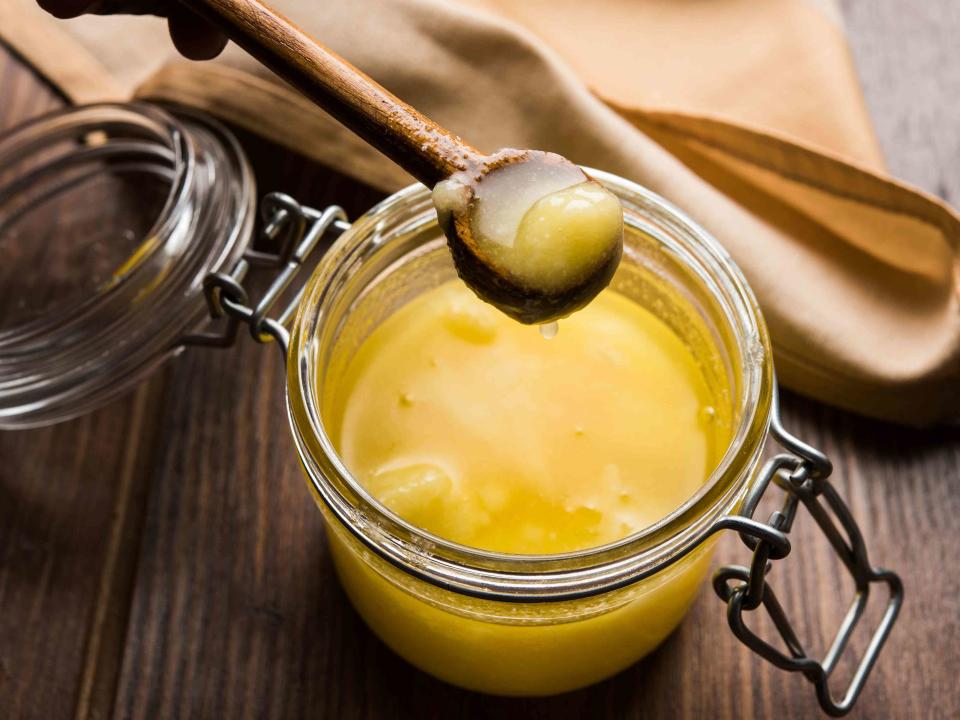Ghee vs. Clarified Butter: Is There a Difference?
They’re mighty similar, but are they actually interchangeable?

subodhsathe/Getty Images
From cooking shows to grocery store shelves, both ghee and clarified butter have become popular points of conversation and, increasingly, more common on counters. In a few such conversations, when someone has shown a curiosity as to what ghee is, the response I've often heard is a flippant, "it's just clarified butter." But is it really the same thing?
The difference between these two butter-based ingredients might seem subtle, but it shouldn't be overlooked. The truth is — all ghee is clarified butter, but not all clarified butter is ghee.
What's the Difference Between Ghee and Clarified Butter?
Because they are so similar, it's beneficial to note all the ways ghee and clarified butter are alike before discussing how they're different.
First and foremost, both products consist of butter without milk solids. The absence of these solids means a variety of things: They're great options for high-heat cooking (like sautéing, frying, and roasting) due to a high smoke point, they're stable enough to store on the counter or in the pantry for long periods of time, and, because the sugar lactose and the protein casein vanish along with the butter's milk solids, they're useful for those who suffer from lactose intolerance or follow paleo diets. (Both are still off-limits for vegans, though).
Beyond being an unctuous spread, butter is really most useful in baking and low-heat preparations. Throwing in a knob of butter to finish a sauce? Perfection. Throwing a knob in a pan to cook vegetables? Not even close (it will brown and burn quickly). Clarified butter and ghee are much more stable and less likely to oxidize during cooking, making them a better choice than almost all vegetable oils.
The process for making both clarified butter and ghee begins with adding butter to a saucepan over low heat and cooking until its water content evaporates and its milk solids separate. But here lies the key difference: Removing the pan from the heat at this stage and straining it will result in clarified butter. However, if you continue to cook the butter a bit longer, until the separated milk solids turn a dark golden brown and settle at the bottom of the pan before straining, you will have ghee. Yes, this means that ghee is essentially clarified brown butter, or as the French call it, beurre noisette.
Clarified butter is most often associated with French cooking, often a feature in French cuisine. Ghee, on the other hand, originated in India, its stability a natural companion to the country's warm climate. It’s featured not only in South Asian cuisine, but in India's regional medicine, Ayurveda.
Can Ghee and Clarified Butter Be Used Interchangeably?
They sure can!
Ghee has a nuttier flavor compared to clarified butter due to the extra cooking/browning time. This means ghee will give an extra boost and add a level of authenticity to Indian dishes, not to mention other subtle hints of flavor in dishes that clarified butter can't deliver. Alton Brown, the food encyclopedia himself, suggests using it to make popcorn or fry up steak and eggs. He also says it makes a mean hollandaise and if he says it, you know it's true.
If you're eager to try such things, you're in luck. It's much more likely you'll find ghee on the shelf in a store than clarified butter. Unless you're ordering directly from a restaurant, from a web-to-restaurant store, or other food service company — it'll be ghee. If you'd like clarified butter, plan on making it at home.
And completing the process to make it is well worth the effort. After the heating and straining process, both clarified butter and ghee will solidify when left at room temperature and are able to be kept in the pantry for several months, or in the fridge up to one year.

